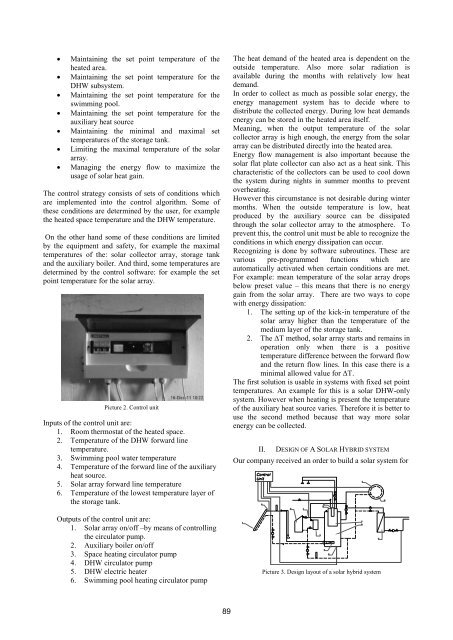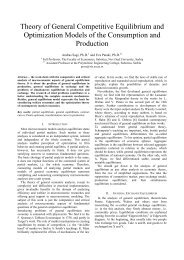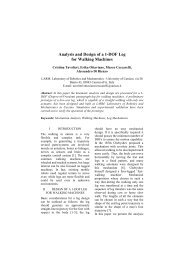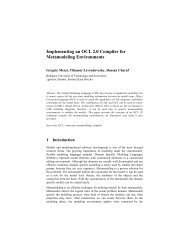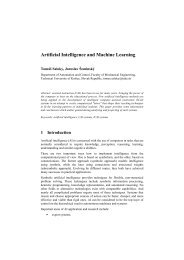Final Program EXPRES 2012 - Conferences
Final Program EXPRES 2012 - Conferences
Final Program EXPRES 2012 - Conferences
- No tags were found...
Create successful ePaper yourself
Turn your PDF publications into a flip-book with our unique Google optimized e-Paper software.
Maintaining the set point temperature of theheated area.Maintaining the set point temperature for theDHW subsystem.Maintaining the set point temperature for theswimming pool.Maintaining the set point temperature for theauxiliary heat sourceMaintaining the minimal and maximal settemperatures of the storage tank.Limiting the maximal temperature of the solararray.Managing the energy flow to maximize theusage of solar heat gain.The control strategy consists of sets of conditions whichare implemented into the control algorithm. Some ofthese conditions are determined by the user, for examplethe heated space temperature and the DHW temperature.On the other hand some of these conditions are limitedby the equipment and safety, for example the maximaltemperatures of the: solar collector array, storage tankand the auxiliary boiler. And third, some temperatures aredetermined by the control software: for example the setpoint temperature for the solar array.Picture 2. Control unitInputs of the control unit are:1. Room thermostat of the heated space.2. Temperature of the DHW forward linetemperature.3. Swimming pool water temperature4. Temperature of the forward line of the auxiliaryheat source.5. Solar array forward line temperature6. Temperature of the lowest temperature layer ofthe storage tank.Outputs of the control unit are:1. Solar array on/off –by means of controllingthe circulator pump.2. Auxiliary boiler on/off3. Space heating circulator pump4. DHW circulator pump5. DHW electric heater6. Swimming pool heating circulator pumpThe heat demand of the heated area is dependent on theoutside temperature. Also more solar radiation isavailable during the months with relatively low heatdemand.In order to collect as much as possible solar energy, theenergy management system has to decide where todistribute the collected energy. During low heat demandsenergy can be stored in the heated area itself.Meaning, when the output temperature of the solarcollector array is high enough, the energy from the solararray can be distributed directly into the heated area.Energy flow management is also important because thesolar flat plate collector can also act as a heat sink. Thischaracteristic of the collectors can be used to cool downthe system during nights in summer months to preventoverheating.However this circumstance is not desirable during wintermonths. When the outside temperature is low, heatproduced by the auxiliary source can be dissipatedthrough the solar collector array to the atmosphere. Toprevent this, the control unit must be able to recognize theconditions in which energy dissipation can occur.Recognizing is done by software subroutines. These arevarious pre-programmed functions which areautomatically activated when certain conditions are met.For example: mean temperature of the solar array dropsbelow preset value – this means that there is no energygain from the solar array. There are two ways to copewith energy dissipation:1. The setting up of the kick-in temperature of thesolar array higher than the temperature of themedium layer of the storage tank.2. The ΔT method, solar array starts and remains inoperation only when there is a positivetemperature difference between the forward flowand the return flow lines. In this case there is aminimal allowed value for ΔT.The first solution is usable in systems with fixed set pointtemperatures. An example for this is a solar DHW-onlysystem. However when heating is present the temperatureof the auxiliary heat source varies. Therefore it is better touse the second method because that way more solarenergy can be collected.II.DESIGN OF A SOLAR HYBRID SYSTEMOur company received an order to build a solar system forPicture 3. Design layout of a solar hybrid system89


